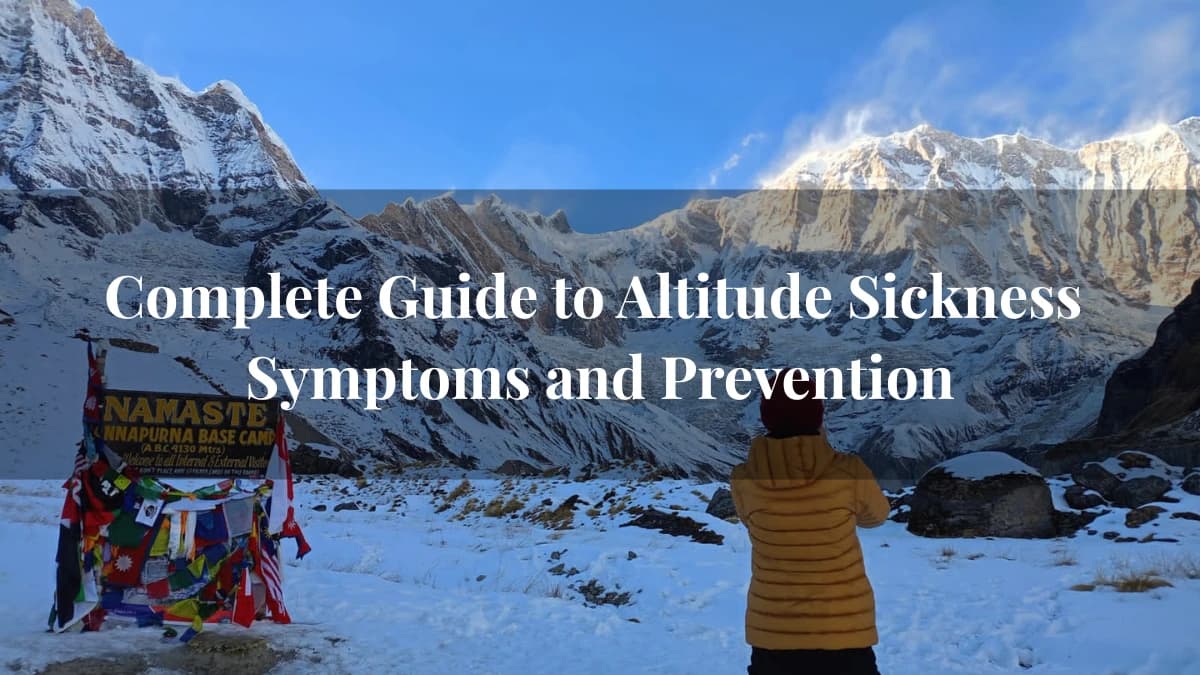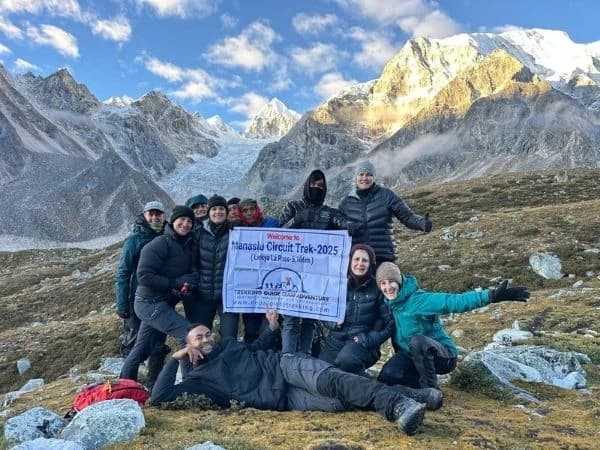Introduction
Altitude sickness, or Acute Mountain Sickness (AMS), is one of the most prevalent difficulties encountered by trekkers traveling to the great heights of the Himalayas. It primarily happens when your body encounters a fight systems oxygen scarcity at height, generally over 2500 meters. From mild headaches and weariness to severe ailments requiring descent and medical assistance, the symptoms associated with altitude sickness AMS are many.
For those trekking in Nepal’s Everest Intensive Zone, considered one of the country’s most famous trails together. Similiarly, Annapurna circuit and Langtang Valley which progresses towards higher altitudes such as Mera Peak or Manaslu, a clear understanding of this ailment is a must as while taking in the views is simply unmatched mesmerizing vistas. Unfortunately, many trekkkers fall victim to experiencing altitude sickness due to a rapid increase in elevation without proper acclimatization.
This article highlights relevant information about altitude such as AMS its causes, and symptoms. Above all, some important and easy to implement prevention measures aimed to ensure safe and enjoyable trekking.
What is Altitude Sickness?
Altitude sickness, is a condition that is often affects the trekkers or climbers who hike high altitude very quickly without considering ample time for acclimatization. It is caused because the body cannot adapt to the high altitude where the oxygen level is relatively low. This condition is also commonly known as Acute Mountain Sickness (AMS)
Definition of Acute Mountain Sickness (AMS)
The most common form of altitude sickness is Acute Mountain Sickness (AMS). It can be identified with the symptoms such as mild headache, fatigue, feeling nauseous, dizzy, little or no appetite and so on.
Usually after 6 to 24 hours of arriving to the high elevations above 2500 meteres, the symptoms become prominent.
When Does It Occur?
It usually causes when you reach an altitude of 2500 meters or above and specially if you didn’t give your body enough time to adapt to the increasing altitude with low oxygen low, acclimatization. On top of that if you go too fast with inadequate rest and hydration, the level of the risk increases dramatically. So, it is important to identify and address the early symptoms so that it does not progress into severe conditions.
Types of Altitude Sickness
Based on the level of severity, there are three major types of altitude sickness
1. Acute Mountain Sickness (AMS)
This is the most common and mildest form of altitude sickness. Common symptoms that can be identitied in AMS are:
- Mild headache - early symptom
- Feeling dizzy
- Little or complete loss apetite
- Feeling nauseous or vomitting
- Weakness or fatigue
- Lack of sleep or difficulty while sleeping
2. High Altitude Pulmonary Edema (HAPE)
High Altitude Pulmonary Edema (HAPE) is a hazardous condition of altitude sickness. It causes fluid (plasma) to accumulate in the lungs, which interferes with the exchange of oxygen. It is caused by vasoconstriction - the narrowing of blood vessels due to low oxygen.
It normally occurs when you dismiss the early signs and continue ascending. The symptoms of HAPE are:
- Difficulty and shortness and breathe even though you are in rest position.
- Continous cough sometimes followed my sputum with blood.
- The color of fingernails and lips turning into blue (cyanosis)
- Tightness in the chest
- Extreme fatigue and exhaustion
3. High Altitude Cerebral Edema (HACE)
It is the most serious case of altitude sickness. It is affects your brain because it causes the swelling the brain because of the lack of oxygen. When the AMS progresses rapidly, it can cause HACE.
Symptoms of HACE are as follows:
- Difficulty walking
- Disorientation or confusion
- Ataxia, or loss of coordination
- Hallucinations or behavioral abnormalities
- In worst cases, unconsciousness
HACE needs emergency care and descending right away.
Common Symptoms of Altitude Sickness
- Mild symptoms: headache, nausea, fatigue, dizziness, shortness of breath
- Severe symptoms (in case of HAPE/HACE): chest tightness, hallucination, disorientation, confusion, inability to walk, vomiting and unconsciousness
Who Is at Risk?
Although anyone can get altitude sickness, there are some things that make it much much more probable that someone would experience symptoms when traveling or trekking at high altitudes.
1. Travelers and Trekkers Above 2,500 Meters
Trekking and mountaineering, along with high-altitude tourism such as flying or driving to places like Lhasa or Leh increases the risk of altitude sickness. For climbers and trekkers the peril of experiencing symptoms come with elevations above 2,500 meters (8,200 feet). The risk is intensified after further ascent beyond 3,500 meters.
2. Lack of Acclimatization or Rapid Ascent
Not being able to take breaks and sleeping less than recommended while climbing significantly increases the chances of headache, fatigue, nausea and so on. Further skipping acclimatization approaches in hike leads you especially towards severe headaches paired alongside utter exhaustion. It is a clear indicator that your body is not prepared for sudden elevation changes. When it comes in approach through gradual is best. Similarly, if you fly directly to the high-altitude region, you are also at great risk of altitude sickness.
3. People With Existing Health Problems
There are pre troubling conditions which may complicate with existing issues. This includes:
- Conditions affecting the respiratory system, such as asthma or chronic bronchitis
- Cardiovascular disorders, such as heart problems or hypertension
- A previous episode of migraines, which can resemble or intensify the symptoms of altitude sickness.
- Insomnia or sleep apnea, which can get worse at altitude
Nevertheless some physically fit trekkers with good health conditon can also become victim if you neglect the acclimatization approach.
Prevention of Altitude Sickness
Anyone can be at the risk of altitude sickness above the altitude of 2500 meters. The best approach to prevent this are:
1. Ascend Gradually
There is a popular rule: "Climb high, sleep low"
- Try not to exceed 500m per day in sleeping altitude especially if you are above 3000 meters.
- Plan your itinerary such that you get rest days every 2-3 days. This will help you avoid altitude sickness.
2. Acclimatization Days

Like rest days, acclimatization days are equally important. It is essential for adjustment of our body with the lower oxygen levels. Simply you should make use of this days to be more calm and adjust with the altitude.
3. Stay Hydrated and Eat Well
Due to the altitude and physical activity your body will lose water in the form of sweat. So, you will be dehydrated. Make sure that you drink at least 2-3 liters of water each day. To sustain energy and assist your body in adjusting to low oxygen levels, eat well-balanced meals, particularly those high in carbohydrates.
4. Abstain from Alcohol and Smoking
It highly is recommended to avoid smoking and alcohol at any cost. Smoking and drinking can signficantly reduce the oxygen absorption and also increase dehydration which increase your risk of altitude sickness.
5. Listen to Your Body
You should be careful and notice the signs like persistent headache, cough, nausea and so on.
- Don’t ignore symptoms.
- Rest or descend immediately if they worsen
Appropriate decision can help you prevent HAPE and HACE.
6. Use Medication if Necessary
While you should always consult a doctor before taking any medication for altitude sickness, the most common medications you can take are:
-
Diamox (Acetazolamide) helps with acclimatization. Common dose: 125–250mg twice daily.
- Ibuprofen or paracetamol can relieve headaches.
What to Do If You Get Altitude Sickness
Quick decision making is important if you start experiencing altitude sickness so as to prevent it from getting severe.
Immediate Steps
- Stop climbing right away.
- Take it easy, stay hydrated, and keep an eye on your health.
- For headaches, take paracetamol or ibuprofen.
When to Stop Trekking
Even after you take medications, rehydrate and take rest, your condition doesn't improve, it is best to stay at your current altitude and not ascend higher.
When to Descend
- If your symptoms increase, or if you have trouble walking, difficulty breathing, or disorientation, descend at least 500–1,000 meters.
- The best treatment is descending; do not wait for serious symptoms to "pass."
Altitude Sickness in Nepal: Region-wise Notes
The table below shows the popular trekking regions in Nepal along with the highest point, level of risk and the support Trekking Guide Team Adventure provides to prevent it.
| Trekking Region | High Elevation Points | Altitude Risk | How we support you |
|---|---|---|---|
| Everest Base Camp Trek | Kala Patthar (5,545m), EBC (5,364m) | High | Acclimatization at Namche & Dingboche, trained guides |
| Annapurna Circuit | Thorong La Pass (5,416m) | High | Extra nights in Manang, acclimatization, health checks |
| Langtang Valley | Tserko Ri (4,984m), Kyanjin Ri (4,773m) | Moderate | Rest and acclimatization day at Kyanjin |
| Manaslu Circuit | Larkya La Pass (5,160m) | High | Rest and acclimatization day at Samagaun |
| Gokyo | Gokyo Ri (5,357m), Renjo La (5,360m) | High | Extra day at Gokyo, oxygen support, monitored ascent pace |
| Upper Mustang | Lo Manthang (3,840m), passes up to ~4,200m | Moderate | Slow-paced itinerary, low daily altitude gain, local support |
Conclusion
Exploring the Himalayas is relatively easy for seasoned trekkers; however, keeping safe at high altitudes demands a lot of attention and forethought. While on trek, keep an eye out for altitude sickness symptoms. Most importantly, look after your health first.
Your adventure in Nepal doesn’t have to be ruined by altitude sickness due to bad planning. Health hazards can easily be avoided if you take the necessary precautions well in advance. It's important to take care during Everest Base Camp, Thorong La, or Mustang Hidden Valleys treks.
Our experts are ready to help you with any inquiries on how to trek using safe practices with customized plans. You can contact us anytime and we'll get back promptly for expert assistance so that you trek with greater peace of mind and safety.









